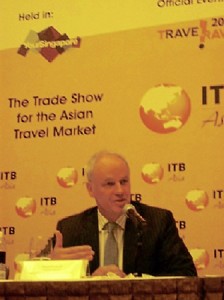Yes, PH can attract more tourists, but …

THE PHILIPPINE tourism booth at the Travel Rave Expo, Sands Expo and Exhibition Center, Singapore. Photo by Marlet D. Salazar
The country’s tourism line that “It’s more fun in the Philippines” is boosted by new data from the World Tourism Organization.
The date shows international tourist arrivals worldwide grew by 5 percent or 467 million tourists this year with the Asia-Pacific region posting the strongest gains.
The gains are affirmed by a study conducted by global travel market research company PhoCusWright which states that Apac is set to gain $357 billion in travel and tourism in 2013.
The optimism in the Asian travel and tourism industry was shared by industry leaders and movers during the annual TravelRave 2012 held in Singapore recently.
Neeta Lachmandas, Singapore Tourism Board’s assistant chief executive officer, sees that by the year 2020, the global spend on tourism whether inbound or outbound will grow by 40 percent.
“It is important for us to create a platform for travel industry leaders and players and harness the goodness in Asia,” she says during the first-day press conference. “It is equally important to embrace the challenges and because Asian tourists are different in their own ways, we have to start strategizing and collaborating.”
Growth in SEA
Southeast Asia reported a strong start this year with a growth of 9 percent and an increase of 3.1 million additional international visitors. Most of these visitors come from the Americas, Europe and Asia which account for 90 percent of international arrivals.
TravelRave 2012 was also the venue for the annual ITB Asia’s Trade Show for Asian Travel Market running on its fifth year. The dynamic travel market is evident with a significant increase of 15 percent from last year among participants from 72 countries.
“We saw a double-digit growth in all segments of the show,” says Martin Buck, vice president, Messe Berlin Singapore (MSB), organizer of ITB Asia.
The Philippines’ Department Tourism (DOT), together with a couple of travel agencies participated in the travel expo held at The Sands Expo and Exhibition Center, Marina Bay Sands. The agencies, Ang’s Travel and Tours, Pan Pacific Travel Corp., and Shroff International Travel Care Inc., hoped to attract the wholesale and retail market.
However, if the Philippines wants the share of the pie of Asian tourism’s multibillion dollar earnings, the government needs to work on having direct flights to prime tourist destinations. Majority of the foreigners randomly asked by SundayBiz the reason why they don’t visit the Philippines replied, “You don’t have direct flights to Cebu, or Palawan, or Boracay. It’s a bit of a hassle to go to Manila then change planes.”
ITB Asia posted 865 exhibiting companies that needed an increase of 13 percent in gross floor space and 17 percent increase in net floor space compared to last year which was held in Suntec, Singapore.
Visa simplification
Buck also reported that ITB Asia had already sold out as early as five months ahead of the schedule with the top four industry sectors well-represented in the show: hotels and resorts, tour operators, tourism organizations and associations, and travel agencies as well as business travel and MICE (meetings, incentives, conventions and exhibitions).
David Scowsill, president and CEO of World Travel and Tourism Council (WTTC), says “WTTC is forecasting growth for the overall region of almost 6 percent in 2012 which is triple the growth of Europe. There are variations within the region with strength in China, India, Indonesia and the Philippines compensating for the weaker growth in Australia, New Zealand, Singapore and Thailand, but the overall picture is one of dramatic growth over both the short-term and long-term.”
He added that in 10 years, there shall be a 9- to 10-percent growth in the industry creating about 328 million jobs. For the travel industry to flourish even more, governments and players need to focus on addressing challenges such as taxation, visas and sustainability.
He encouraged government agencies to simplify visa applications. “We want electronic visas and visas on arrival,” he says. “The United States lost $600 billion (in tourism) in the last 10 years due to visa refusal.”
MAC drives growth
Lachmandas adds that the mass affluent class (MAC) or high-end mass market especially those from China, India and Indonesia generate more outbound travel posting $300 billion. “There is a huge appetite for travel,” she says. “And this opens for more opportunities.”
TravelRave 2012 also provided a venue for movers and players to engage in dynamic conferences that tackled the challenges, changes, and even evolutions concerning the travel industry.
The high-level “Asia Travel Leaders Summit” saw industry leaders from hotel groups and business travel sharing insights on how they as competitors make the industry more vibrant to lure more and more visitors in Asia. The “Tourism Destination Investment Conference” explored the development of tourism infrastructure in the region with special conference on “Hotel Technology.”
The fifth annual “Aviation Outlook” focused on market opportunities especially now that budget airlines provide opportunities for more travelers who could not travel before because of steep cost of airfare.
TravelRave is an annual travel festival initiated by the Singapore Tourism Board. This year’s week-long expo is in partnership with Messe Berlin Singapore, Pan Pacific Hotel Singapore and Questex Media Group.


